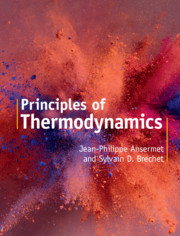Refine search
Actions for selected content:
5486 results in Thermal-fluids engineering
11 - Thermodynamic Stability and Phase Change
-
- Book:
- Statistical Thermodynamics
- Published online:
- 17 December 2018
- Print publication:
- 20 December 2018, pp 166-177
-
- Chapter
- Export citation
1 - Introduction
-
- Book:
- Statistical Thermodynamics
- Published online:
- 17 December 2018
- Print publication:
- 20 December 2018, pp 1-8
-
- Chapter
- Export citation
13 - Spectroscopy
-
- Book:
- Statistical Thermodynamics
- Published online:
- 17 December 2018
- Print publication:
- 20 December 2018, pp 196-215
-
- Chapter
- Export citation
References
-
- Book:
- Statistical Thermodynamics
- Published online:
- 17 December 2018
- Print publication:
- 20 December 2018, pp 257-260
-
- Chapter
- Export citation
14 - Chemical Kinetics
-
- Book:
- Statistical Thermodynamics
- Published online:
- 17 December 2018
- Print publication:
- 20 December 2018, pp 216-231
-
- Chapter
- Export citation
7 - The Photon and Electron Gases
-
- Book:
- Statistical Thermodynamics
- Published online:
- 17 December 2018
- Print publication:
- 20 December 2018, pp 122-131
-
- Chapter
- Export citation
4 - Quantum Mechanics
-
- Book:
- Statistical Thermodynamics
- Published online:
- 17 December 2018
- Print publication:
- 20 December 2018, pp 57-91
-
- Chapter
- Export citation
2 - Fundamentals of Macroscopic Thermodynamics
-
- Book:
- Statistical Thermodynamics
- Published online:
- 17 December 2018
- Print publication:
- 20 December 2018, pp 9-35
-
- Chapter
- Export citation
Frontmatter
-
- Book:
- Statistical Thermodynamics
- Published online:
- 17 December 2018
- Print publication:
- 20 December 2018, pp i-iv
-
- Chapter
- Export citation
Acknowledgements
-
- Book:
- Statistical Thermodynamics
- Published online:
- 17 December 2018
- Print publication:
- 20 December 2018, pp xx-xx
-
- Chapter
- Export citation
E - Boltzmann’s Equation
-
- Book:
- Statistical Thermodynamics
- Published online:
- 17 December 2018
- Print publication:
- 20 December 2018, pp 247-251
-
- Chapter
- Export citation
A - Physical Constants
-
- Book:
- Statistical Thermodynamics
- Published online:
- 17 December 2018
- Print publication:
- 20 December 2018, pp 232-232
-
- Chapter
- Export citation

Statistical Thermodynamics
- An Engineering Approach
-
- Published online:
- 17 December 2018
- Print publication:
- 20 December 2018
-
- Textbook
- Export citation

Flow Control Techniques and Applications
-
- Published online:
- 14 December 2018
- Print publication:
- 13 December 2018

Principles of Thermodynamics
-
- Published online:
- 14 December 2018
- Print publication:
- 03 January 2019
8 - Synthetic Jet
-
- Book:
- Flow Control Techniques and Applications
- Published online:
- 14 December 2018
- Print publication:
- 13 December 2018, pp 168-205
-
- Chapter
- Export citation
7 - Jet
-
- Book:
- Flow Control Techniques and Applications
- Published online:
- 14 December 2018
- Print publication:
- 13 December 2018, pp 141-167
-
- Chapter
- Export citation
Preface
-
- Book:
- Flow Control Techniques and Applications
- Published online:
- 14 December 2018
- Print publication:
- 13 December 2018, pp ix-x
-
- Chapter
- Export citation
5 - Polymer
-
- Book:
- Flow Control Techniques and Applications
- Published online:
- 14 December 2018
- Print publication:
- 13 December 2018, pp 94-107
-
- Chapter
- Export citation
1 - Introduction
-
- Book:
- Flow Control Techniques and Applications
- Published online:
- 14 December 2018
- Print publication:
- 13 December 2018, pp 1-22
-
- Chapter
- Export citation
